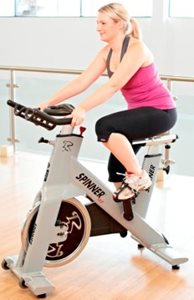Seated cycling first

The Pelvic Floor First campaign, run by the Continence Foundation of Australia, identified a number of exercises which are considered at ‘higher risk’ of causing pelvic floor problems. One of these is cycling with high resistance or when your bottom is lifted off the seat, which is usually when you are putting more effort in.
Simple maths says:
High risk exercise + High risk time i.e., in the first few months after having a baby = HIGH risk of developing pelvic floor problems.
There are a number of other factors involved of course, such as your previous fitness level, including that of your pelvic floor, the length of the pushing stage of your labour and how big your baby was at birth. Your body type also plays a part with the stretchiness of your supporting ligaments and the fibrous tissue in your body having an effect too in how your pelvic floor is affected by pregnancy and childbirth.
So if for example, you had a big baby, a long pushing stage and also needed help for your baby to be born which is another factor such as a forceps delivery, then you also are at greater risk of your pelvic floor muscles being weaker and more stretched following birth. Pelvic floor exercises, pregnancy and postnatal abdominal bracing exercises when done correctly are an important step in protecting, strengthening and maintaining these muscles, and our 0-3 week Firm Foundations TM program highlights the starting point for these. You can then move on to the 3-8 week postnatal exercise program which gives you more to work on while your body is strengthening after the birth, and the effects of the softening hormones of pregnancy are leaving your body.
So when cycling, start with low resistance, and stay seated on the bike, to protect your pelvic floor by providing it with some support. As you get stronger, and want to increase your aerobic workout capacity, then increase the resistance slightly, checking that as you do your body is able to stay steady on the bike. If you are swaying a lot from side to side at this stage, it means that your pelvis and core area are not stable and you are using your trunk to help get momentum. When you push down with your legs, if your pelvis and core are stable, then there shouldn’t be a lot of sideways movement at this stage. If there is, back off with the resistance, and build it up slowly again the next week. Continue with the 3-8 week Firm Foundations TM postnatal exercise program, which specifically works on these areas.
To view a video by Physiotherapist Michelle Kenway on choosing correct core muscle exercises while protecting and preventing downwards pressure on your pelvic floor, watch
“Pelvic Floor Safe Core Exercises”
This video is also for women who have a prolapse or have had pelvic floor surgery, and this is an important time to protect your pelvic floor, become aware and to prevent the development of longer term pelvic floor problems, which are common.
As you increase your resistance in the first 8 weeks after the birth, if you feel that your oblique abdominals, the muscles at the side of your waist are working a lot, that you are holding your breath or sucking in the upper abdominal muscle area, then this resistance is too hard for you now. This increase in IAP (the pressure inside your abdominal wall is called intra abdominal pressure), is what can push down on your pelvic floor muscles. Any pelvic floor that has been through pregnancy and birth, is unlikely to be able to fully counteract the forces of this pressure and unless you are very confident with your pelvic floor capacity to withstand this force, then reduce this resistance for now, to protect your pelvic floor while it is still strengthening and firming in these early months.
.jpg.aspx) As you move to being 3-4 months postnatal, the effects of pregnancy hormones should be leaving your body, although some effects can remain while women are breastfeeding. Your abdominal muscles should now be getting stronger and you will be more able to control your pelvic and core position whilst on the bike. It is now, that you can start to lift your bottom off the seat and steadily increase your resistance, again checking that your pelvic floor is not feeling any bearing down pressure upon it, and that your trunk and upper body is able to remain steady as you do.
As you move to being 3-4 months postnatal, the effects of pregnancy hormones should be leaving your body, although some effects can remain while women are breastfeeding. Your abdominal muscles should now be getting stronger and you will be more able to control your pelvic and core position whilst on the bike. It is now, that you can start to lift your bottom off the seat and steadily increase your resistance, again checking that your pelvic floor is not feeling any bearing down pressure upon it, and that your trunk and upper body is able to remain steady as you do.
Proudly supporting

Copyright 2011-2020. Demac Resources Pty Ltd. www.thepregnancycentre.com.au
Photos Copyright 2011-2020. Continence Foundation of Australia. Used with permission.